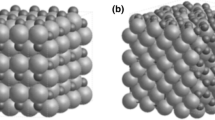Abstract
The development of advanced Nd-Fe-B permanent magnet materials with high coercivity draws much attention to the relation between coercivity and microstructure at the grain boundaries of the magnets. A disordered face-centered cubic (fcc)-NdO x phase formed at the interface of Nd/Nd-Fe-B is observed, and it is believed to take an important role in coercivity generation. To have a thorough understanding of the formation mechanism of this particular oxide and its relation to the surface coercivity, a ground state analysis for whole oxygen concentration in Nd-O has been performed by combining the LSDA + U and the cluster expansion method. Systematic calculations revealed that a sequent fcc-based structure formed by introducing oxygen vacancies into NdO is stable in almost all the 0–50% oxygen concentration range, whereas in a series of hexagonal close-packed (hcp)-based structures developed from hP5-Nd2O3 no stable structure is observed, which coincides with the experimental measurement very well. A further analysis of formation energies and relevant changes in electronic structures of single oxygen vacancy in various structures revealed the insight of such fcc-based phase formation and further explained the relation between the phase stability and coercivity.





Similar content being viewed by others
References
S. Hirosawa, T. Fukagawa, and T. Maki, Phys. Status Solidi C 4, 4606 (2007).
W. Mo, L. Zhang, and Q. Liu, Scr. Mater. 59, 179 (2008).
T. Fukagawa and S. Hirosawa, J. Appl. Phys. 104, 013911 (2008).
T. Fukagawa and S. Hirosawa, Scr. Mater. 59, 183 (2008).
T. Fukagawa, S. Hirosawa, T. Ohkubo, and K. Hono, J. Appl. Phys. 105, 07A724 (2009).
Y. Chen, S. Hirosawa, and S. Iwata, Mater. Sci. Forum 654, 1674 (2010).
G. Kresse and D. Joubert, Phys. Rev. B 59, 1758 (1999).
G. Kresse, VASP, Vienna Ab Initio Simulation Package (2004). http://www.vasp.at.
P.E. Blochl, Phys. Rev. B 50, 17953 (1994).
P. Perdew, Phys. Rev. B 46, 6671 (1992).
A.I. Liechtenstein, V.I. Anisimov, and J. Zaane, Phys. Rev. B 52, R5467 (1995).
A. Shankar, D.P. Rai, Sandeep, and R.K. Thapa, J. Semicond. 33, 082001 (2012).
W. Connolly and A.R. Williams, Phys. Rev. B 27, 5169 (1983).
Axel van de Walle, CALPHAD 33, 266 (2009).
M. Matsuura, N. Tezuka, and S. Sugimoto, Paper presented at the Proceedings of the 22nd International Workshop on Rare-Earth Permanent Magnets and their Applications (Nagasaki, Japan, September 2012), P3-016.
M. Matsuura (Doctoral dissertation, Graduate school of Engineering, Tohoku University, Japan, 2012).
G. Hrkac, T.G. Woodcock, and C. Freeman, Appl. Phys. Lett. 97, 232511 (2010).
Acknowledgements
This work is supported by the Elements Strategy Initiative Center for Magnetic Materials (ESICMM) under the outsourcing project of MEXT. The authors would like to express their sincere thanks to the crew of Center for Computational Materials Science of the Institute for Materials Research, Tohoku University, for their continuous support of the SR11000/SR16000 supercomputing facilities.
Author information
Authors and Affiliations
Corresponding author
Rights and permissions
About this article
Cite this article
Chen, Y., Saengdeejing, A., Matsuura, M. et al. Formation of the Face-Centered Cubic (FCC)-NdO x Phase at Nd/Nd-Fe-B Interface: A First-Principles Modeling. JOM 66, 1133–1137 (2014). https://doi.org/10.1007/s11837-014-1004-1
Received:
Accepted:
Published:
Issue Date:
DOI: https://doi.org/10.1007/s11837-014-1004-1




